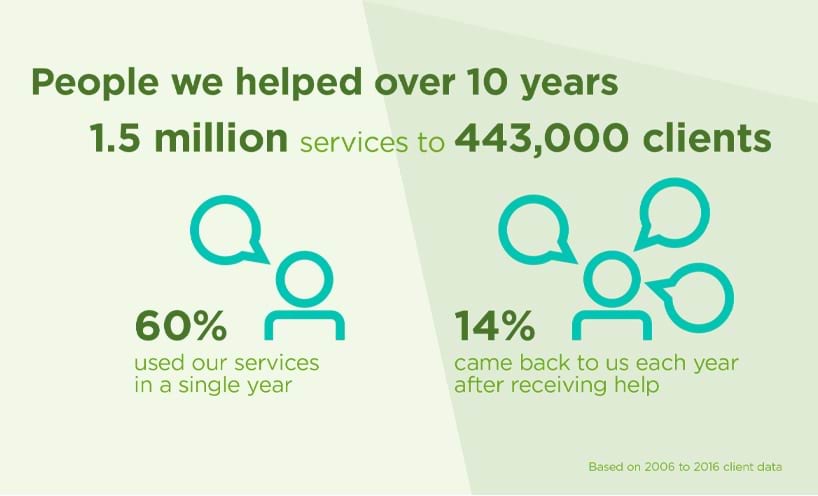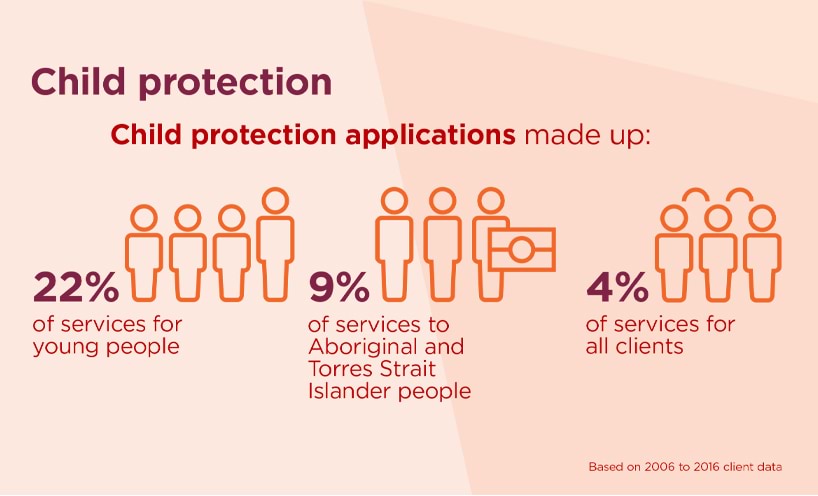We partnered with Analytics for Change in 2016 to analyse our client data over a ten-year period, from 2006 to 2016.
Non-identifying data about our clients was used to analyse:
- key characteristics of our clients, including age, location, type of service received and other key demographic characteristics
- the prevalence of co-occurring legal problems
- key client groups, including young people (10–17 years of age) and people from culturally diverse backgrounds, including people with Aboriginal and Torres Strait Islander background
- frequency of use, including clients who use our most costly services.
Key findings
From 2006 to 2016, we provided 1.5 million services to 443,000 clients. Sixty per cent used our services in a single year, while 14 per cent came back to us each year after first receiving help.
An analysis of this client data included the following findings.
Child protection
Child protection is the most common legal problem among young people and people with Aboriginal and Torres Strait Islander background.
This compares with our general client population, for which family violence intervention orders is the most common legal matter they seek help from us with.
Child protection applications made up 22 per cent of services for young people, 9 per cent of services to people with Aboriginal and Torres Strait Islander background, and 4 per cent of services for all clients.
Child protection is most likely to co-occur with other legal problems. For young people, child protection problems happen alongside assault, family violence or burglary.
For people with Aboriginal and Torres Strat Islander background, child protection happens alongside family violence and assault.
One-fifth of our clients will experience legal problems in more than one area of law
Many legal problems are interrelated, and experiencing one issue can lead to other legal problems.
The most common crossover category were clients who needed help from both our family and criminal law programs. Some clients also had civil legal problems alongside either family or criminal problems.
Family violence will often happen alongside other types of legal issues
Our data shows that a family violence problem often does not occur in isolation. A significant number of clients who had received help for family violence also received help for other types of legal problems.
The most common matters that coincided with family violence were disputes over parenting arrangements, child protection or being charged with assault.
Clients with a disability
More services were provided to clients with a disability with Aboriginal and Torres Strait Island background (25 per cent) and among high-cost users (23 per cent) than the general client population (13 per cent).
Links to previous research
These findings are consistent with our previous analysis of high contact users of legal aid services.
Our previous research also found that clients who had contact with us at a young age or are from an Aboriginal and Torres Strait Islander background were more likely to become frequent users of our services. These clients often sought legal help with child protection and family violence matters at a young age.
Relevance to our work
This research re-confirms that we need to support young people and their families earlier and with more tailored supports to help them avoid future legal problems.
Find out more about ways we are focusing on ensuring that children, young people and families can benefit from targeted services that are timely and help reduce the need for future assistance:
- Child Protection Legal Aid Services Review
- Care Not Custody – A new approach to keep kids in residential care out of the criminal justice system
You can also read about our strategic advocacy and law reform activities on appropriate interventions for children and young people.
Updated



